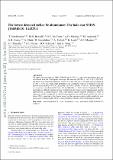| dc.contributor.author | Nordlander, T | |
| dc.contributor.author | Bessell, M S | |
| dc.contributor.author | Da Costa, G S | |
| dc.contributor.author | Mackey, A D | |
| dc.contributor.author | Asplund, M | |
| dc.contributor.author | Casey, A R | |
| dc.contributor.author | Chiti, Anirudh | |
| dc.contributor.author | Ezzeddine, Rana | |
| dc.contributor.author | Frebel, Anna L. | |
| dc.contributor.author | Lind, K | |
| dc.contributor.author | Marino, A F | |
| dc.contributor.author | Murphy, S J | |
| dc.contributor.author | Norris, J E | |
| dc.contributor.author | Schmidt, B P | |
| dc.contributor.author | Yong, D | |
| dc.date.accessioned | 2020-10-28T20:49:05Z | |
| dc.date.available | 2020-10-28T20:49:05Z | |
| dc.date.issued | 2019-07 | |
| dc.date.submitted | 2019-06 | |
| dc.identifier.issn | 1745-3925 | |
| dc.identifier.issn | 1745-3933 | |
| dc.identifier.uri | https://hdl.handle.net/1721.1/128230 | |
| dc.description.abstract | We report the discovery of SMSS J160540.18−144323.1, a new ultra metal-poor halo star discovered with the SkyMapper telescope. We measure Fe/H = -6.2 ± 0.2 (1D LTE), the lowest ever detected abundance of iron in a star. The star is strongly carbon-enhanced, C/Fe = 3.9 ± 0.2$, while other abundances are compatible with an α-enhanced solar-like pattern with Ca/Fe = 0.4 ± 0.2, Mg/Fe = 0.6 ± 0.2, Ti/Fe = 0.8 ± 0.2, and no significant s- or r-process enrichment, Sr/Fe < 0.2 and Ba/Fe < 1.0 (3σ limits). Population III stars exploding as fallback supernovae may explain both the strong carbon enhancement and the apparent lack of enhancement of odd-Z and neutron-capture element abundances. Grids of supernova models computed for metal-free progenitor stars yield good matches for stars of about 10M[subscript⨀] imparting a low kinetic energy on the supernova ejecta, while models for stars more massive than roughly 20M[subscript⨀] are incompatible with the observed abundance pattern. | en_US |
| dc.language.iso | en | |
| dc.publisher | Oxford University Press (OUP) | en_US |
| dc.relation.isversionof | http://dx.doi.org/10.1093/mnrasl/slz109 | en_US |
| dc.rights | Creative Commons Attribution-Noncommercial-Share Alike | en_US |
| dc.rights.uri | http://creativecommons.org/licenses/by-nc-sa/4.0/ | en_US |
| dc.source | arXiv | en_US |
| dc.title | The lowest detected stellar Fe abundance: the halo star SMSS J160540.18−144323.1 | en_US |
| dc.type | Article | en_US |
| dc.identifier.citation | Nordlander, T. et al. "The lowest detected stellar Fe abundance: the halo star SMSS J160540.18−144323.1." Monthly Notices of the Royal Astronomical Society: Letters 488, 1 (July 2019): L109–L113 © 2019 The Author(s) | en_US |
| dc.contributor.department | Massachusetts Institute of Technology. Department of Physics | en_US |
| dc.contributor.department | MIT Kavli Institute for Astrophysics and Space Research | en_US |
| dc.relation.journal | Monthly Notices of the Royal Astronomical Society: Letters | en_US |
| dc.eprint.version | Original manuscript | en_US |
| dc.type.uri | http://purl.org/eprint/type/JournalArticle | en_US |
| eprint.status | http://purl.org/eprint/status/NonPeerReviewed | en_US |
| dc.date.updated | 2020-10-23T13:55:44Z | |
| dspace.orderedauthors | Nordlander, T; Bessell, MS; Da Costa, GS; Mackey, AD; Asplund, M; Casey, AR; Chiti, A; Ezzeddine, R; Frebel, A; Lind, K; Marino, AF; Murphy, SJ; Norris, JE; Schmidt, BP; Yong, D | en_US |
| dspace.date.submission | 2020-10-23T13:55:52Z | |
| mit.journal.volume | 488 | en_US |
| mit.journal.issue | 1 | en_US |
| mit.license | OPEN_ACCESS_POLICY | |
| mit.metadata.status | Complete | |
